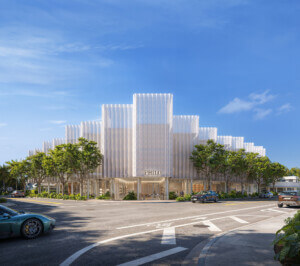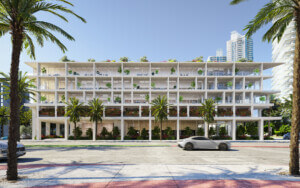Walter Meyer and Jennifer Bolstad, founders of and partners in Local Office Landscape and Urban Design (LOLA), are earning a reputation for their innovative resiliency projects at the edges of civilization—coastlines and islands. With a multipronged approach that they describe as part architecture, part environmental remediation, and part community organization, Meyer and Bolstad are battling the effects of environmental change on cities and their populations. Managing editor Olivia Martin talked with them about LOLA’s approach to resiliency and future-proofing the planet—from working on post-Hurricane Sandy conditions in the Rockaways to remediating coastal areas of Florida.
The Architect’s Newspaper (AN): You say that resiliency is the new sustainability. Why?
Walter Meyer: It’s a new buzzword, so people confuse it and interchange it with sustainability as though they are the same thing. But sustainability is a derivative of Frederic Clements’s climax theory, in which a field, for example, will change each decade, from soil to weeds to shrubs to trees and then climax as a hardwood forest—this is a snapshot of nature in 3-D.
What emerged after World War II was a new theory of the natural cycles of time. Rather than seeking an equilibrium theory of nature, there is a disequilibrium, where nature is trying to balance itself and adapt to change. Those who can anticipate and respond to change quicker are the ones who have the upper hand.
The big difference is that resiliency is dynamic and changing, while sustainability is static. In terms of scale, sustainability is holistic and more big-picture, and resiliency is more local. So I think of sustainability as an old model but still an important tool.
AN: Do you have examples of where sustainability failed us and why it should no longer be considered the gold standard, so to speak?
Jennifer Bolstad: Well, a few years ago, I consulted on One World Trade Center, which is a very sustainable building [LEED Gold]. But when the mechanical system drowned in Hurricane Sandy and couldn’t be used anymore, the firm in charge ultimately decided it was cheaper to abandon it and leave several floors uninhabited rather than fix it.
Meyer: Also during Hurricane Sandy, all of the buildings that ran on photovoltaics failed because the city grid was down. So, literally, every single building with solar was down. This is because there is a law that if the grid goes down, you can’t back charge the line with your solar panels, because you’ll zap the workers trying to fix the grid. Since then, they invented a hybrid inverter that “islands” the building into a microgrid, so it can function independently off of the grid. There needs to be a dynamic relationship with nature, and we should be creating multilayered systems.
AN: You have a lot of work in Florida right now that deals with water management. How does resiliency factor into those projects?
Meyer: All of the articles written about Miami focus on the ocean and city. It’s all about the ocean—and that makes for good headlines. But what’s missed is that Miami’s most vulnerable areas are in the Everglades, on the west side of the city, because they have freshwater, five feet higher than the ocean, that can’t become diluted with salt water or else Miami loses its water source.
The area near Everglades National Park is particularly at risk because the main flow of the water runs north–south, down from Lake Okeechobee to Florida Bay, and a secondary flow of water runs east–west—like a spine and ribs. Originally, the secondary water flow moved through transverse glades and occasionally wet bogs and sloughs. Since the channels weren’t actual rivers, the city filled them in, and now, when it rains, the houses on those streets along these former sloughs flood. The homes are considered Repetitive Loss properties and the owners cannot collect insurance for the damage anymore. The buildings’ foundations are cracking, due to the water infiltrating the alkaline bedrock, literally melting it. We are trying to open up more options to the people who are stuck in these houses but don’t want to leave their community.
Normally, there is a lot of discussion about design activists, but we are more like community organizers—we want to engage the residents themselves. It’s a lot of listening and then designing and showing them what legal options are available, or creating new ones. One option is a CLT, a community land trust—where everyone buys into this idea, and you work with a public–private partnership, such as a developer and the county. For this neighborhood, it’s about creating high density along the edge of the vulnerable corridor, along the slough of the transverse glades, and doing this three blocks at a time.
If you can organize just three blocks—the center of the slough, a transitional, and a bank—then this creates a housing swap, where the residents can continue their normal lives and not have their schedules disrupted. So, for example, you can move out of the home into a temporary housing unit; then the home will be demolished and turned into a flood storage park, and you will have the option of moving or the right of first refusal to a new high-density, 40-percent affordable housing unit nearby. This makes more sense than simply moving everyone to higher ground because, then, those who are already at higher ground could be dislocated due to rising real estate costs—already Florida developers are looking at luxury housing inland—and this creates new levels of climate refugees.
AN: So, resiliency aside, is relocating more responsible than fixing?
Meyer: Well, that is what leads to climate gentrification; the issue of scale is a major one. If you take a holistic approach and just get everyone out of harm’s way, then you aren’t paying attention to the social fabric. For example, Staten Island was a state buyout project; the government essentially said, “We’ll buy your house, and you can take the money and run.” The problem with that is then the people basically had to move out to Newark because the buyout price point doesn’t acknowledge the gentrification, and $200,000 or $300,000 won’t get you another house in the city. In the Edgemere Urban Renewal Area, in Rockaway, the Department of Housing Preservation and Development and the Office of Recovery and Resiliency offered more options than just a buyout—such as housing swaps and other solutions at the neighborhood scale.
Bolstad: We focus on the built environment in a way that looks at how cultural issues touch the ecological issues. In the Florida project, people very much want out of their houses that are constantly flooding, but they still want to stay within a five-mile radius so they can be near family and keep their routines. It’s not a one-size-fits-all approach, even if you believe in a long-term retreat from those areas. Otherwise, you end up with people who are not there by choice, like when Robert Moses dislocated people in the Bronx in the 1960s and moved them out to the beach. Economically vulnerable populations ended up in environmentally vulnerable areas.
And it’s not just the built environment. Even if we aren’t preserving the area for housing in the long term, then the environmental situation needs to remain. That barrier [the Rockaway peninsula] is the first line of defense in the city and Lower Manhattan, and, without active management of the environment of that place, it risks the rest of New York City.
Meyer: I like to quote my mentor and city planner Ronald Shiffman when we talk about these issues: “These disturbances don’t discriminate, but our reaction to them can.” We want to make the most just city we can.
For more on LOLA’s projects, see their website.










